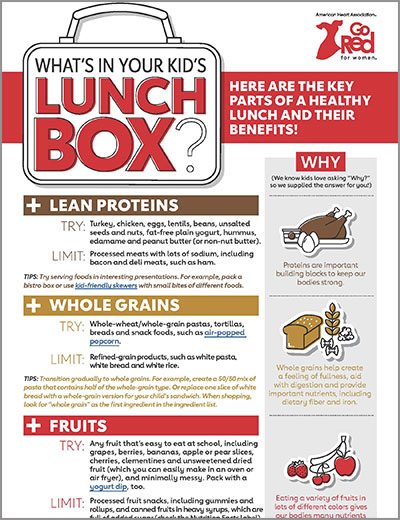What’s in Your Kid’s Lunchbox Infographic
Here are the key parts of a healthy lunch and their benefits!
Why: We know kids love asking “Why?” so we supplied the answer for you!
Lean proteins
Try: Turkey, chicken, eggs, lentils, beans, unsalted seeds and nuts, fat-free plain yogurt, hummus, edamame and peanut butter (or non-nut butter).
Limit: Processed meats with lots of sodium, including bacon and deli meats, such as ham.
Tips: Try serving foods in interesting presentations. For example, pack a bistro box or use kid-friendly skewers with small bites of different foods.
Why: Proteins are important building blocks to keep our bodies strong.
Whole grains
Try: Whole-wheat/whole-grain pastas, tortillas, breads and snack foods, such as air-popped popcorn.
Limit: Refined-grain products, such as white pasta, white bread and white rice.
Tips: Transition gradually to whole grains. For example, create a 50/50 mix of pasta that contains half of the whole-grain type. Or replace one slice of white bread with a whole-grain version for your child’s sandwich. When shopping, look for “whole grain” as the first ingredient in the ingredient list.
Why: Whole grains help create a feeling of fullness, aid with digestion and provide important nutrients, including dietary fiber and iron.
Fruits
Try: Any fruit that’s easy to eat at school, including grapes, berries, bananas, apple or pear slices, cherries, clementines and unsweetened dried fruit (which you can easily make in an oven or air fryer), and minimally messy. Pack with a yogurt dip, too.
Limit: Processed fruit snacks, including gummies and rollups, and canned fruits in heavy syrups, which are full of added sugar (check the Nutrition Facts label).
Tips: Squeeze a bit of fresh lemon juice over pear and apple slices to prevent them browning then sprinkle them with a bit of cinnamon or schmear of peanut butter. Or try Apple Nachos!
Why: Eating a variety of fruits in lots of different colors gives our bodies many nutrients and can help reduce the risk of some diseases, including heart disease.
Vegetables
Try: Easy-to-eat choices, such as baby carrots, bell pepper strips, cucumber spears, grape/cherry tomatoes and celery sticks.
Limit: Canned or frozen vegetables in sauces, which can be full of sodium (check the Nutrition Facts label).
Tips: Pack an insulated container with veggie-packed lunches, such as vegetarian chili or vegetable soup, or with a “green monster” smoothie loaded with spinach.
Why: Eating more vegetables provides our bodies with many vitamins and minerals and can help reduce the risk of some diseases, including heart disease.
Fat-free/Low-fat Dairy
Try: Fat-free/low-fat yogurt, cheese and milk, including nondairy sugar-free milks fortified with calcium and vitamin D.
Limit: High-fat options, such as full-fat dairy products, including yogurt, cheese and butter.
Tips: Make a yogurt parfait and pack it in an insulated container or with an ice pack.
Why: Foods with calcium and vitamin D are important for growing and maintaining strong bones and teeth.
Beverages
Try: Water (best choice) or fat-free/low-fat (unflavored) milk.
Limit: Sugary drinks, such as sodas, sports drinks and juice (no more than 4 ounces a day of 100% juice — the whole fruit is the healthier option). Tips: Infuse water with slices of citrus, cucumber rounds, berries and/or fresh herbs, such as mint, basil or cilantro.
Why: Staying hydrated prevents overheating and helps the body process food.
Adapt the suggestions above to meet your child’s dietary needs (including food allergies) and food preferences.
View or download
What’s in your kid’s lunchbox? (PDF)

